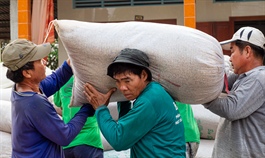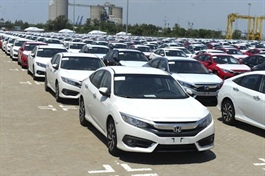Viet Nam needs to promote brand building for rice exports
Viet Nam needs to promote brand building for rice exports
While 2020 has been a successful year for Vietnamese rice exports, more must be done to accelerate the development of the national rice brand, experts have said.

Rice export prices in Viet Nam jumped to their highest point since December 2011 last week, as a shortage of containers sent freight rates soaring and pushed Thai prices to a near four-month peak.
Prices for Viet Nam’s 5 per cent broken rice hit US$500 per tonne, from the previous week’s $470-$490, Reuters reported.
A shortage of containers has made it difficult for traders to ship rice to customers, a trader based in the Mekong province of An Giang said.
For instance, freight rates for a 20-feet container to Africa have risen to $5,000 from $1,500 a couple of months ago, the trader added.
Meanwhile, at the World Rice Trade Conference 2020 held by The Rice Trader (TRT) in earlier December, Vietnamese rice ST25 was named the second-best rice in the world. Last year, it was given first prize in Manila, the Philippines.
The TRT World Rice Conference is the largest annual gathering of commercial and professional rice industry participants in the world.
This is good news for Vietnamese rice and the rice exports are forecast to grow strongly in the future.
The prize is also an opportunity to create a brand for Vietnamese rice, according to the agricultural experts, because after more than 30 years of exporting, Viet Nam's rice industry only has a national brand logo.
Thailand and Cambodia have branded their rice to improve promotion activities on the global market and create confidence in quality. Therefore, their rice products have higher selling prices, Pham Thai Binh, General Director of Cong Trung An High-Tech Agriculture Joint Stock Company, told Nhip cau dau tu (Investment Bridge) newspaper. Meanwhile, local traders could not gain high prices for high-quality rice without a national brand, he said.
Viet Nam is among the world's top rice exporters with the value the second highest in the world. Therefore, Prime Minister Nguyen Xuan Phuc recently approved a project to develop Viet Nam's rice brand. Specifically, by 2030, Viet Nam is hoped to have stable, efficient and sustainable regions producing rice for export to build the world's leading brand in food quality and safety for Vietnamese rice.
The project calls for Viet Nam to restructure the rice production industry with investment in some varieties to increase the value of rice seeds. However, in the Mekong Delta, the largest rice production region in the country, the creation of a large field model has not achieved the expected efficiency.
Unprofessional production makes it difficult to build a brand, said Lam Dinh Quoc, former director of the Soc Trang Food Company.
Therefore, Loc Troi Group is building an ecosystem in rice production where the group and farmers produce rice under orders from large companies. Recently, the group has exported more than 126 tonnes of fragrant rice to the EU under the EU-Vietnam Free Trade Agreement (EVFTA). This is the first shipment to enjoy the zero tax rate since the agreement came into effect.
“The EU is a huge rice importer from 2.3-2.5 million tonnes per year. So, with the EVFTA and control in rice quality, Viet Nam’s rice exports to this market will increase in the future," said Le Quoc Doanh, Deputy Minister of Agriculture and Rural Development.
Exports in 11 months
In the first 11 months of this year, Viet Nam's rice exports exceeded 5.7 million tonnes, earning nearly $2.83 billion. The average price was $496 per tonne, according to the General Department of Customs.
Exports reduced by about 3 per cent in volume but surged by 9.7 per cent in turnover and about 13 per cent in average price over the same period in 2019.
In November alone, the nation exported 351,515 tonnes of rice, earning $189 million with an average price of $537.6 per tonne. This export decreased by 3.3 per cent in volume but increased by 12.8 per cent in turnover and by 16.7 per cent in price.
During the first 11 months, the Philippines was the largest export market for Vietnamese rice with a volume of 1.94 million tonnes, accounting for 34 per cent of the country's total, earning $910.16 million. The figures were down 1.7 per cent in volume but up 11.8 per cent in value year-on-year.
Some markets with strong growth in rice export volume from Viet Nam included Indonesia (up 181 per cent), Australia (58.2 per cent) and the EU (23 per cent).
However, Viet Nam saw a high reduction of rice exports in some other markets, such as Iraq (65.6 per cent), Hong Kong (24.7 per cent) and Senegal (32.5 per cent).























